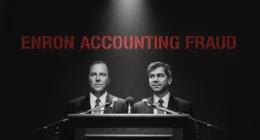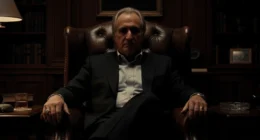The Black Turtleneck and the Lie
September 8, 2021. A San Jose courtroom. Elizabeth Holmes walked to the defendant’s table wearing her signature black turtleneck—a deliberate imitation of Steve Jobs. She was 37 years old. Moreover, she was nine months pregnant. Additionally, she faced 20 years in prison.
The charges: Wire fraud. Conspiracy to defraud investors and patients. Specifically, lying about Theranos’s blood-testing technology for years. Furthermore, endangers patient lives with false test results.
Holmes had been called the next Steve Jobs. The youngest self-made female billionaire. Moreover, a revolutionary who would democratize healthcare. Additionally, a genius who’d change medicine forever.
Instead, she was a fraud. Her technology never worked. Her claims were lies. Additionally, her company endangered lives. And she knew it all along.
This is the Theranos fraud. A Silicon Valley con that fooled billionaires, politicians, and the media. Consequently, it raised $945 million on false promises. Meanwhile, it put patients at risk with inaccurate tests. And it exposed how easily charisma trumps evidence.
Let’s investigate how a 19-year-old dropout built a $9 billion company on lies.

The Origin: A 19-Year-Old’s Vision
Stanford Dropout
Elizabeth Holmes entered Stanford University in 2002 at age 18. She studied chemical engineering. Moreover, she wanted to change healthcare. Additionally, she was obsessed with making an impact.
In 2003, during her sophomore year, she had an idea: What if blood tests could be done with just a few drops from a finger prick? Moreover, what if results came in hours instead of days? Additionally, what if it were cheap and accessible?
Traditional blood tests required:
- Venipuncture (needle in vein)
- Large blood volumes
- Expensive lab equipment
- Days for results
- Trained phlebotomists
Holmes envisioned a device that needed:
- Finger prick only
- Tiny blood sample
- Portable analyzer
- Immediate results
- Anyone could operate it
The idea was revolutionary. However, the science was impossible with current technology. But Holmes believed she could solve it.
At 19, she dropped out of Stanford. She used her tuition money to start Theranos (combining “therapy” and “diagnosis”). Additionally, she recruited early employees. Furthermore, she began pitching investors.
The Early Pitch
Holmes’s pitch was compelling:
The Problem:
- Blood tests are expensive
- People avoid them due to needles
- Results take too long
- Healthcare is reactive, not preventive
The Solution:
- Theranos device (later called “Edison”)
- One drop of blood
- 200+ tests from a single sample
- Results in 4 hours
- Cheap, accessible, revolutionary
The Vision:
- Devices in every home
- Preventive healthcare transformation
- Early disease detection
- Lives saved globally
Investors loved it. They believed Holmes was a genius. Additionally, her confidence was magnetic. Furthermore, the market opportunity was huge.
The Steve Jobs Imitation
Holmes deliberately cultivated a Steve Jobs image:
The Look:
- Black turtlenecks daily
- No makeup
- Intense stare
- Minimalist aesthetic
The Voice:
- Artificially deepened voice (to sound authoritative)
- Slow, deliberate speech
- Pregnant pauses
- Intensity in every word
The Language:
- “Revolutionary” technology
- “Changing the world”
- “Making an impact”
- “The next big thing”
She studied Jobs obsessively. She copied his presentation style. Additionally, she mimicked his product launches. Furthermore, she demanded the same secrecy and loyalty.
The imitation worked. People saw her as the female Steve Jobs. Moreover, they invested based on that image. Additionally, they ignored warning signs because they believed in the narrative.

The Technology That Never Worked
The Edison Device
Theranos’s main product was the Edison blood analyzer. This device supposedly:
- Analyzed one drop of blood
- Ran 200+ different tests
- Delivered accurate results in hours
- Cost pennies per test
The problem? It never actually worked.
Reality:
- Edison could only run 12 tests (not 200+)
- Results were wildly inaccurate
- Device frequently malfunctioned
- Blood samples were too small for analysis
Internal scientists repeatedly told Holmes the technology wasn’t ready. Moreover, they said more development was needed. Additionally, they warned against deploying it. She ignored them.
The Minilab Failure
When Edison consistently failed, Theranos developed “miniLab,” a smaller, portable device. This also failed to work reliably. Moreover, it had the same fundamental problems. Additionally, miniaturization made accuracy worse, not better.
The science was clear: You cannot run comprehensive blood tests on tiny samples with portable devices. Moreover, existing technology couldn’t achieve what Holmes promised. Additionally, her timeline was impossible.
But Holmes kept claiming it worked.
The Secret: Commercial Analyzers
Here’s what Theranos actually did:
The Deception:
- Patients gave finger-prick samples at Theranos centers
- Theranos told patients that samples would be analyzed on the Edison
- Actually, Theranos diluted samples
- Then ran them on commercial Siemens analyzers (standard equipment)
- Siemens machines generated results
- Theranos reported these as “Edison results”
Patients never knew. Moreover, investors never knew. Additionally, partners like Walgreens didn’t know. Everyone believed Edison was working.
This wasn’t innovation. It was fraud.
The Patient Danger
Using commercial machines with diluted samples caused serious problems:
The Issues:
- Dilution altered blood chemistry
- Results were inaccurate
- False positives and false negatives
- Patients received the wrong information
- Medical decisions based on bad data
Real Consequences:
- Cancer patients got the wrong results
- Pregnancy tests showed false positives
- HIV tests gave inaccurate readings
- Patients made health decisions on faulty information
Theranos knew the results were unreliable. Moreover, they knew patients were at risk. Nevertheless, they continued operating. Lives were literally endangered for profit.
The Hype Machine
The Board of Stars
Holmes assembled an impressive board of directors:
Board Members:
- George Shultz (Former Secretary of State)
- Henry Kissinger (Former Secretary of State)
- William Perry (Former Secretary of Defense)
- Sam Nunn (Former Senator)
- James Mattis (Former Secretary of Defense, later General)
- Richard Kovacevich (Former Wells Fargo CEO)
- Riley Bechtel (Bechtel Corporation Chairman)
Notably absent: Medical professionals, blood testing experts, scientists who understood the technology.
The board was for credibility, not oversight. Moreover, they didn’t question the technology. Additionally, they trusted Holmes completely. Furthermore, their prestige attracted more investors.
The Media Blitz
Holmes became a media sensation:
2014 Coverage:
- Fortune cover: “This CEO Is Out For Blood”
- Forbes: “America’s Self-Made Women”
- Time: “One of the 100 Most Influential People”
- Inc.: “Entrepreneur of the Year”
The Narrative:
- 30-year-old female CEO
- Stanford dropout like Steve Jobs
- Revolutionizing healthcare
- Youngest self-made female billionaire (net worth: $4.5 billion on paper)
The media loved the story. They rarely questioned the science. They focused on Holmes’s personality. Furthermore, they promoted the narrative without verification.
The Walgreens Partnership
In 2013, Theranos partnered with Walgreens. The pharmacy chain would offer Theranos blood tests in stores. Moreover, Walgreens invested $140 million. Additionally, they planned to roll out to thousands of locations.
This partnership gave Theranos mainstream legitimacy. However, Walgreens did minimal due diligence. Moreover, they didn’t verify that the technology worked. Additionally, they trusted Holmes’s claims.
By 2015, Theranos operated “wellness centers” in 40 Walgreens locations in Arizona and California. Thousands of patients received tests. Moreover, many results were wrong.
The Safeway Deal
Safeway also partnered with Theranos. They built special blood-testing clinics in stores and invested $350 million in infrastructure. Additionally, they redesigned store layouts.
Then Theranos couldn’t deliver working devices. The partnership collapsed. Safeway lost hundreds of millions. Additionally, executives faced consequences for the failed deal.

The Whistleblowers
Tyler Shultz: The Grandson
Tyler Shultz was George Shultz’s grandson. He joined Theranos in 2013 as a scientist. Initially, he believed in the mission. However, he quickly discovered problems.
What He Saw:
- Tests were inaccurate
- Quality control was ignored
- Patient safety was compromised
- Management hid failures
- The technology didn’t work
Tyler reported concerns internally. Moreover, he was ignored. Additionally, he was threatened. Furthermore, Holmes’s boyfriend and COO, Sunny Balwani, intimidated him.
So Tyler became a whistleblower. He contacted regulators. Moreover, he spoke to journalists. Additionally, he risked everything to expose the truth.
The Cost:
- Theranos sued him
- His grandfather (board member) sided with Holmes
- Legal fees exceeded $400,000
- Family relationships destroyed
- Career threatened
But Tyler persisted. His courage eventually exposed Theranos.
Erika Cheung: The Lab Employee
Erika Cheung worked in Theranos’s lab. She saw the same problems Tyler did. She witnessed patient test failures. Additionally, she knew the danger was real.
She also became a whistleblower. Moreover, she provided evidence to regulators. Additionally, she corroborated Tyler’s claims. Her testimony was crucial.
Others Who Spoke Up
Multiple employees tried to expose Theranos:
- Scientists fired for raising concerns
- Lab technicians who saw failures
- Engineers who knew technology didn’t work
- Executives who witnessed fraud
Many were silenced through lawsuits and NDAs. However, enough spoke up to eventually trigger an investigation.

John Carreyrou: The Reporter Who Broke It
The Investigation
John Carreyrou, investigative reporter at The Wall Street Journal, received a tip in 2015. Someone said Theranos’s technology didn’t work. Patient tests were unreliable. Additionally, the company was committing fraud.
Carreyrou investigated for months. He interviewed whistleblowers. He examined medical records. Additionally, he analyzed company documents. Furthermore, he verified technical claims.
Theranos fought back aggressively:
- Threatened WSJ with lawsuits
- Sent lawyers to intimidate Carreyrou
- Pressured WSJ’s publisher
- Tried to discredit sources
- Used political connections
But Carreyrou had the evidence. Moreover, his sources were credible. Additionally, the science supported his findings.
The Bombshell Article
October 15, 2015. The Wall Street Journal published “Hot Startup Theranos Has Struggled With Its Blood-Test Technology.”
The article revealed:
- Edison could only run 12 tests
- Most tests used commercial machines
- Results were often inaccurate
- Company misled investors and partners
- Patient safety was compromised
The article was devastating. Moreover, it was undeniable. Additionally, it started Theranos’s collapse[14].
Theranos’s Response
Holmes denied everything. She appeared on Jim Cramer’s Mad Money. Moreover, she did a CNBC interview. Additionally, she called Carreyrou’s reporting false.
“This is what happens when you work to change things,” she said. “First they think you’re crazy, then they fight you, then you change the world.”
But more whistleblowers came forward. Moreover, regulators began investigating. Additionally, the evidence mounted against Theranos.
The Collapse (2015-2018)
Regulatory Action
Centers for Medicare & Medicaid Services (CMS) inspected Theranos labs in 2015. They found:
- Quality control violations
- Inaccurate test results
- Patient safety risks
- Regulatory non-compliance
In July 2016, CMS banned Holmes from owning or operating a lab for two years. Moreover, they threatened to shut down Theranos completely.
The Lawsuits
Legal actions flooded in:
Walgreens: Sued for $140 million investment Partner Fund Management: Sued for $96.1 million
Patients: Class action for false results SEC: Civil fraud charges DOJ: Criminal investigation
The Shutdown
By September 2018, Theranos was finished:
- All testing operations ceased
- Remaining assets sold
- Company officially dissolved
- Employees laid off
- Investors lost everything
Total raised: $945 million
Total recovered: ~$0
Investor recovery rate: 0%
Criminal Charges
June 2018: Federal prosecutors indicted Elizabeth Holmes and Sunny Balwani (COO) on:
- Wire fraud (9 counts)
- Conspiracy to commit wire fraud (2 counts)
Maximum sentence: 20 years per count.

The Trial (2021-2022)
The Prosecution’s Case
Prosecutors presented overwhelming evidence:
The Fraud:
- Holmes knew technology didn’t work
- She lied to investors repeatedly
- She fabricated partnerships with Pfizer and the military
- She used fake demos with doctors
- She endangered patients knowingly
The Evidence:
- Internal emails showing Holmes knew
- Texts revealing awareness of problems
- Testimony from scientists she ignored
- Financial records showing intentional deception
- Patient records showing harm
- Holmes’s Defense
Her legal team tried multiple strategies:
Defense 1: Abusive Relationship Holmes claimed Sunny Balwani (her boyfriend and Theranos COO) abused and controlled her. Moreover, she said he manipulated her decisions. Additionally, she portrayed herself as a victim.
The jury wasn’t convinced.
Defense 2: She Believed It Would Work Holmes testified she genuinely believed the technology would eventually work. Moreover, she said setbacks were normal for startups. Additionally, she claimed optimism, not fraud.
The evidence contradicted this.
Defense 3: She Didn’t Know Details Holmes claimed she delegated technical decisions. Moreover, she said she relied on experts. Additionally, she didn’t know about specific failures.
Her own emails proved she knew everything.
The Verdict
January 3, 2022. After seven days of deliberation:
Guilty: 4 counts of wire fraud (defrauding investors)
Not Guilty: 4 counts related to defrauding patients
The jury believed she intentionally deceived investors. However, they weren’t convinced beyond a reasonable doubt on patient fraud charges.
Holmes showed no emotion during the verdict.
The Sentencing
November 18, 2022. Judge Edward Davila sentenced Elizabeth Holmes to 11 years and 3 months in federal prison. Additionally:
- $452 million in restitution ordered
- Surrender to prison on May 30, 2023
- No bail during appealHolmes requested leniency. She cited her two young children. Moreover, she expressed remorse. Additionally, she asked for home confinement.
Judge Davila denied it. He said: “The victims of her crimes were real people who suffered real harm.”
Prison
Holmes is currently serving her sentence at Federal Prison Camp Bryan in Texas. She’s 40 years old. Moreover, she’ll be 51 when released. Additionally, her children will grow up with their mother in prison.
Her appeal was denied in 2024. The conviction stands.
Sunny Balwani’s Fate
Ramesh “Sunny” Balwani, Holmes’s boyfriend and Theranos’s COO, was tried separately.
His Role:
- Ran day-to-day operations
- Oversaw the lab
- Intimidated whistleblowers
- Knew technology didn’t work
- Enabled the fraud
His Verdict (July 2022): Guilty on all 12 counts of fraud.
His Sentence (December 2022): 13 years in federal prison—longer than Holmes. Moreover, the judge cited his aggressive role in the fraud.
Balwani is also serving his sentence. He’ll be 71 when released.
The Victims
Investor Losses
Total Invested: $945 million
Total Recovered: Effectively $0
Major Losers:
- Walgreens: $140 million
- Safeway: $350 million
- Rupert Murdoch: $125 million
- Betsy DeVos family: $100 million
- Cox family (Cox Enterprises): $100 million
- Walmart’s Walton family: $150 million
Every major investor lost everything.
Patient Harm
Thousands of patients received inaccurate results:
Documented Cases:
- Cancer tests showing false positives/negatives
- Pregnancy tests inaccurate
- HIV tests are giving wrong results
- Blood clotting tests endanger patients on medication
Brittany Gould: Received a false pregnancy test. Took the abortion pill unnecessarily. Sued Theranos for emotional distress.
Erin Tompkins: Got an inaccurate miscarriage test. Went through unnecessary emotional trauma.
How many more patients were harmed? Nobody knows for certain. However, Theranos ran hundreds of thousands of tests over the years.
Careers Destroyed
George Shultz: The 95-year-old former Secretary of State sided with Holmes over his grandson, Tyler. Family relationships are shattered. He died in 2021, having never fully reconciled with Tyler.
Board Members: Their reputations were damaged for enabling fraud. James Mattis testified he regretted his involvement.
Safeway Executives: Fired after the failed Theranos partnership cost hundreds of millions.
The Lessons
Red Flags Ignored
Secrecy: Theranos operated in complete secrecy. Moreover, they published no peer-reviewed research. They let nobody verify the technology. Any legitimate breakthrough would be published and validated.
Board Without Relevant Expertise: Politicians and generals, not scientists or doctors. This was for prestige, not oversight.
Aggressive Legal Tactics: Theranos sued everyone who questioned them. They used NDAs to silence employees. Additionally, they intimidated whistleblowers. Legitimate companies don’t behave this way.
Personality Cult: Everything centered on Holmes. Moreover, she was compared to Steve Jobs constantly. Additionally, her image mattered more than evidence. Cults of personality hide reality.
Too Good to Be True: Revolutionary blood testing from a finger prick? If it sounds impossible, it probably is. Extraordinary claims require extraordinary evidence. Holmes provided none.
No Working Prototype: After years and $945 million, no working product. Moreover, even demos were faked. This is fraud, not innovation.
How It Happened
Multiple failures enabled Theranos:
Media Failure: Journalists promoted Holmes uncritically. They focused on narrative over science. Additionally, they didn’t verify claims. Press coverage became marketing.
Investor Failure: Due diligence was absent. Moreover, investors trusted reputation over evidence. Additionally, they invested based on Holmes’s charisma. FOMO defeated skepticism.
Regulatory Failure: FDA and CMS were slow to act. They trusted Theranos’s self-reporting. Additionally, they didn’t inspect until whistleblowers forced action.
Board Failure: No scientific expertise. Moreover, they provided no oversight. Additionally, they enabled rather than governed. Boards must actually govern.
Protection Strategies
1. Demand Evidence: Extraordinary claims need extraordinary proof. Moreover, proof means peer-reviewed research. Additionally, independent verification is mandatory.
2. Check Expertise: Are the right experts involved? Moreover, does the board have relevant skills? If politicians replace scientists, something’s wrong.
3. Watch for Secrecy: Innovation isn’t secret. Moreover, legitimate breakthroughs get published. If everything is “proprietary,” it’s probably fake.
4. Verify Independently: Don’t trust the company’s claims. Instead, verify through third parties. Moreover, demand transparency. If they refuse, walk away.
5. Ignore Personality: Charisma isn’t evidence. Moreover, Steve Jobs’ comparisons mean nothing. Judge the science, not the CEO.
6. Look at Track Record: Has this company delivered working products? Moreover, have they published research? If not, why invest?
The Cultural Impact
The Documentary
HBO’s “The Inventor: Out for Blood in Silicon Valley” (2019) exposed Theranos to mainstream audiences. Moreover, it detailed the fraud comprehensively. Additionally, it interviewed victims and whistleblowers.
The Book
John Carreyrou’s “Bad Blood” (2018) became a bestseller. It told the complete Theranos story. It became required reading in business schools. Additionally, it won multiple awards.
The Miniseries
Hulu’s “The Dropout” (2022) dramatized the story. Amanda Seyfried won an Emmy for portraying Holmes. The series showed how the fraud unfolded. Additionally, it humanized the victims.
The Silicon Valley Reckoning
Theranos changed Silicon Valley:
Before Theranos:
- “Fake it till you make it” was acceptable
- Secrecy was praised
- Failure was glorified
- Style over substance
- Move fast, break things
After Theranos:
- Scrutiny increased
- Evidence demanded
- Biotech faces more oversight
- Investors more cautious
The Final Truth
Elizabeth Holmes built a $9 billion company on lies. She endangered patients. Moreover, she defrauded investors. Additionally, she destroyed lives. And she did it all while claiming to save the world.
The most chilling aspect? She almost succeeded. If John Carreyrou hadn’t investigated, Theranos might still be operating. Moreover, more patients would be harmed. Additionally, the fraud would have grown.
Holmes’s genius wasn’t in technology. Instead, it was in manipulation. She understood that people want to believe in revolutionary change. Moreover, she knew charisma trumps evidence. Additionally, she exploited Silicon Valley’s weaknesses: FOMO, ego, and the desire to back the next Steve Jobs.
She wore black turtlenecks and deepened her voice. She assembled a prestigious board. She told a compelling story. Furthermore, she silenced critics ruthlessly. And for years, it worked.
But fraud has a shelf life. Eventually, reality asserts itself. Moreover, lies unravel. Additionally, victims demand justice. And Holmes discovered that prison sentences don’t care about charisma.
She’s 40 years old, serving 11 years in federal prison. Her children will grow up visiting their mother behind glass. Moreover, her reputation is destroyed forever. Additionally, “Theranos” became synonymous with fraud.
The cautionary tale is complete: Intelligence without integrity is worthless. Moreover, ambition without ethics is dangerous. Additionally, confidence without competence kills.
Elizabeth Holmes wanted to change the world. She did—just not how she intended.
She proved that even Stanford dropouts wearing black turtlenecks can be fraudsters. Moreover, she showed that billions in funding mean nothing without working technology. Additionally, she demonstrated that patient lives matter more than founder egos.
And she taught Silicon Valley its most expensive lesson: Sometimes, you can’t fake it till you make it.
Sometimes, you just fake it until you’re making license plates in federal prison.
Resources
[3] Centers for Medicare & Medicaid Services. “CMS Survey and Certification Letter to Theranos.”
Related reading(suggested)
The $65 Billion Bernie Madoff Ponzi: A Complete Victim Analysis
Thodex Scam: How 400,000 Users Lost $2 Billion Overnight
QuadrigaCX Mystery: Did Gerald Cotten Take the Keys to the Grave?











